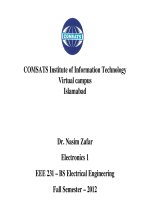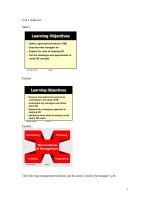Organizational behavior: Lecture 8 - Dr. Mukhtar Ahmed
Bạn đang xem bản rút gọn của tài liệu. Xem và tải ngay bản đầy đủ của tài liệu tại đây (475.21 KB, 46 trang )
Organizational
Behavior
(MGT-502)
Lecture-8
Summary
of
Lecture-7
Values
Components of
Attitudes
• Cognitive -- thinking
• Affective -- feeling
• Behavioral -- doing
Types of Attitudes
• Job satisfaction
• Job involvement
• Organizational
commitment
Outcomes of Job Satisfaction
• Satisfaction and Productivity
• Satisfaction and Turnover
• Satisfaction and Absenteeism
• Satisfaction and Citizenship Behavior
Barriers to Change Attitudes
• Prior Commitments
• Insufficient Information
Today’s Topics
Personality defined
Relatively stable pattern of
behaviours and consistent internal
states that explain a person's
behavioural tendencies.
Personality
The sum total of ways in which an
individual reacts and interacts
with others.
Personality
Mean how people affect others and how
they understand and view themselves,
as well as their pattern of inner and
outer measurable traits and
Person-situation interaction
Personality
Personality refers to a relatively
stable set of feelings and behaviors
that have been significantly formed
by genetic and environmental
factors.
Nature
Hereditary
forces
Personality is a
product of Nature
and Nurture
Nurture
Pattern of life
experiences
12
What Is Personality?
HeredityEnvironmentSituation
Prentice Hall, 2001
Chapter 4
13
Some Major Forces
Influencing Personality
Cultural forces
Hereditary
forces
Individual
Personality
Family
relationship
forces
Social class and
other group
membership forces
Personality
• Personality
– The relatively stable set of psychological
attributes that distinguish one person from
another.
• The “Big Five” Personality Traits
– A set of fundamental traits that are especially
relevant to organizations.
– The traits include agreeableness,
conscientiousness, negative emotionality,
extraversion, and openness.
The Big Five Personality
Model
• Extroversion
– Refers to the tendency to be sociable,
friendly, and expressive.
• Emotional Stability
– Refers to the tendency to experience
positive emotional states.
• Agreeableness
– Being courteous, forgiving, tolerant,
trusting, and self-hearted.
• Conscientiousness
– Is exhibited by those who are
described as dependable, organized,
and responsible.
• Openness to Experience
– Reflects the extent to which an
individual has broad interests and is
willing to be a risk-taker.
Relationship Between The “Big Five”
Personality Dimensions And Career
• The “Big Five” traits are
significantly related to both
intrinsic (job satisfaction) and
extrinsic (income and
occupational status) career
success.
Big five personality
dimensions
Conscientiousness
Caring, dependable
Emotional stability
Poised, secure
Openness to experience
Agreeableness
Extroversion
Sensitive, flexible
Courteous, empathic
Outgoing, talkative
The Myers-Briggs Framework
This framework differentiates people in
terms of four general dimensions:
sensing, intuiting, judging, and
perceiving. Higher and lower positions
in each of the dimensions are used to
classify people into one of sixteen different
personality categories.
Sixteen
Primary
Traits
Personality Traits
Trusting
Suspicious
Practical
Imaginative
Forthright
Shrewd
Self-Assured
Apprehensive
Conservative
Experimenting
Group-Dependent
Self-Sufficient
Uncontrolled
Controlled
Relaxed
Prentice Hall, 2001
Tense
Chapter 4
22
Other Personality Traits at
Work
• Self-Efficacy
– A person’s beliefs about his or her
capabilities to perform a task.
• Authoritarianism
– The extent to which a person believes
that power and status differences are
appropriate within hierarchical social
systems such as organizations.
• Risk Propensity
– The degree to which a person is willing
to take chances and make risky
decisions.
Because personality characteristics
create the parameters for
people’s behavior, they give us a
frame work for predicting
behavior.









